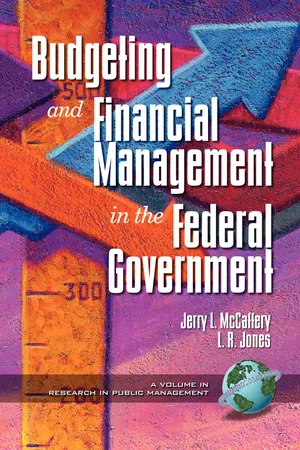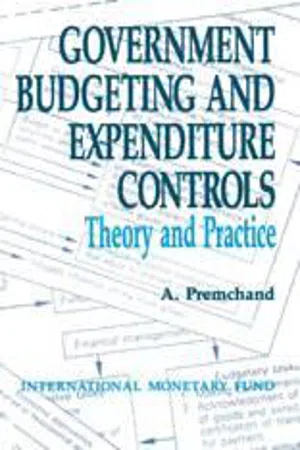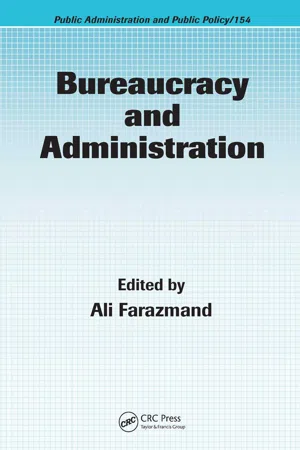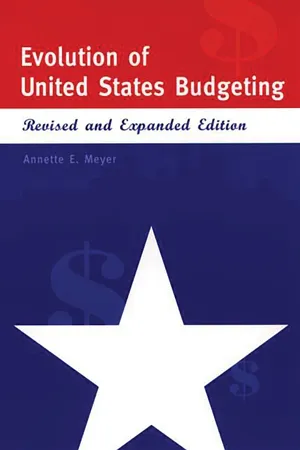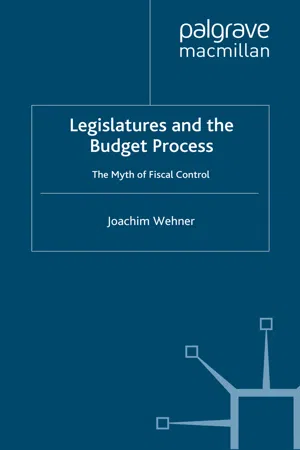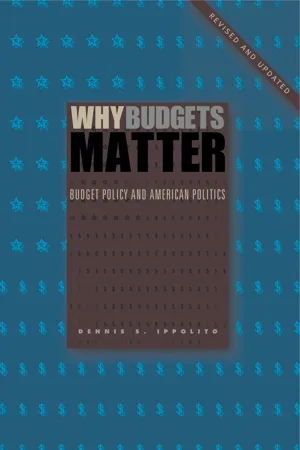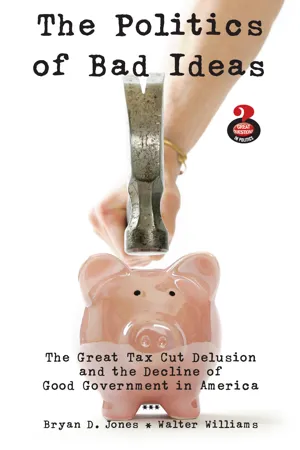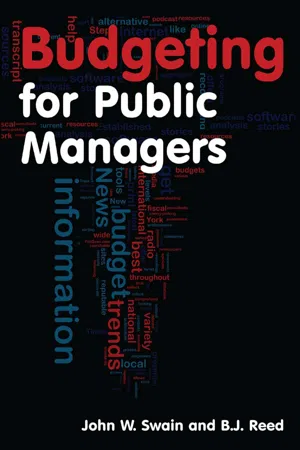Politics & International Relations
Federal Budget
The federal budget refers to the government's plan for spending and revenue over a specific period, typically a fiscal year. It outlines how public funds will be allocated to various programs, services, and initiatives, as well as how the government will generate revenue through taxes and other sources. The budget is a critical tool for policymakers to manage the country's finances and address economic priorities.
Written by Perlego with AI-assistance
Related key terms
1 of 5
9 Key excerpts on "Federal Budget"
- Jerry L. McCaffery, Lawrence R. Jones(Authors)
- 2013(Publication Date)
- Information Age Publishing(Publisher)
18 An Introduction to Public Budgeting and Financial Management We subscribe to the perspectives of both political science—public administration and economics. Our hybrid view attempts to draw in an interdisciplinary manner on both perspectives, which is to say that neither view is wrong—but that each emphasizes different aspects and ways of understanding budgeting and spending outcomes. DEFINING BUDGETING AND THE BUDGET In sending his proposal to create an executive budget system to Congress in 1912, President Taft said: “The Constitutional purpose of a budget is to make government responsive to public opinion and responsible for its acts.” (Burkhead, 1959, p. 19). In the proposal, it was noted that a budget served a number of purposes, from a document for Congressional action, to an instrument of control and management by the President, to a basis for the administration of departments and agencies. The multiple purposes of the budget have been noted, but no one has been more eloquent than Aaron Wildavsky in describing budgetary complexity. In his classic 1964 book, The Politics of the Budgetary Process , Wildavsky explained that a budget is: 1. Concerned with the translation of financial resources into human purposes. 2. A mechanism for making choices among alternative expenditures … a plan ; and if detailed information is provided in the plan, it becomes a work plan for those who administer it. 3. An instrument to attempt to achieve efficiency if emphasis is placed on obtaining desired objective at least cost. 4. A contract over what funds shall be supplied and for what purposes: • between Congress and the President; • between Congress and the Departments and Agencies; • between Departments and Agencies and their subunits. These “contracts” have both legal and social aspects. Those who give money expect results; those who are due to receive money expect to have the funds delivered on time to execute their programs effec-tively.- A. Premchand(Author)
- 1989(Publication Date)
- INTERNATIONAL MONETARY FUND(Publisher)
Broadly, the purposes and associated features of the budget may be considered in terms of three aspects—as a tool of accountability, as a tool of management, and as an instrument of economic policy. Budgeting in the final analysis, regardless of the type of legislature, is a political exercise. From this point of view, a budget is expected to state clearly the purposes of expenditures and provide them in a form that will be useful for legislative action. In addition, the budget is the instrument for accountability, in that the government agencies are responsible for the proper management of funds and programs for which funds are appropriated. It is also a tool for management, because a budget, as an operational document, specifies either directly or implicitly the cost, time, and nature of the expected results.Budgeting as an instrument of economic policy has more varied functions. First, in policy terms, it indicates the direction of the economy and expresses intentions regarding the utilization of the community’s resources. In operational terms, it leads to the determination of the national growth and investment goals and, in more detail, with the allocation of resources among consumption, transfer, and investment outlays and among sectors. Second, a major function of the budget is to promote macroeconomic balance in the economy. The policy choices in this regard include specification of the amount of growth that is compatible with employment, price stability, and balance in the external sector. The economics of budgeting require that due regard be paid to revenue, expenditure, and monetary policies. Available revenues must be allocated among various uses so as to maximize the benefits received. The total revenues required for the purpose are to be managed so as to ensure an equitable distribution of the tax burden and have minimal detrimental effects on the economy. The budget will have to strive toward equating the social benefits of expenditure and the social cost of withdrawal of resources from the private sector. The financing of the budget deficit should be in conformity with the goals of growth and price stability and should be coordinated with monetary policy. In developing countries, this would also involve a careful assessment of foreign aid and external borrowing. Third, with the recent emphasis on distribution of resources in an egalitarian fashion, the budget has become a vehicle for reducing inequalities. The roles of taxation and expenditure programs, as well as the pattern of their distributional effects, must be continuously mapped by the budget. Certainly, distributional goals are sought to be achieved through a variety of instruments, and the budget is an important one. Fourth, the budget should be so organized as to permit a quick and meaningful measurement of its impact on the national economy as a whole. It should permit a determination of the government’s share in national income and the extent to which growth and associated objectives of government are fulfilled by the budget. During recent years, there have been significant advances in the general understanding of the relationship between the budget and the economy and of their reciprocal impact. Associated with these is the recognition that economic policy changes take time to become effective. In turn, the budget is perceived not merely in terms of one year (although for legal purposes, this continues to be the case) but in terms of a period of years. The budget is increasingly visualized as an annual part of a medium-term plan. The structuring of the budget is also expected to fulfill a number of institutional requirements that in turn reflect, although not comprehensively, the complexity of the tasks of economic management. The budget must have a meaningful correlation with the development plan, assist the central bank in assessing the impact on credit and financial institutions, and, in a narrower way, facilitate government management of cash balances and debt.- eBook - PDF
- Ali Farazmand(Author)
- 2009(Publication Date)
- CRC Press(Publisher)
In more recent years, scholars and other observers have considerably revised the dominant characterization of public budgeting in the United States. Levels of political conflict have risen considerably in national, state, and local government budgeting, and much of that conflict has followed ideological and partisan lines. The national government and some states have had consid-erable diffi culty in making budgetary decisions according to a regular timetable, and once budget-ary decisions are made, they are subject to later revision that may be due to errors in forecasting revenues or spending, or political maneuvering, with people who are unhappy with the original decision trying to modify it. Especially since the September 11, 2001, attacks on the World Trade Center and the Pentagon, a number of observers have also noted the importance of international influences on U.S. budgeting; similar, though less dramatic awareness of international influences surfaced in the aftermath of the 1970s oil shocks and the later discussion on the so-called peace dividend after the end of the Cold War. We believe that these developments can be usefully characterized as the globalization of Ameri-can public budgeting. Globalization has a number of different meanings, but for our purposes, two facets of globalization have particular relevance. First, globalization involves a variety of forces and relationships that transcend national boundaries (Tarzi, 1999; Fortanier and Maher, 2001) and may cause different political systems to behave in relatively similar ways, although different systems may respond to those forces in different ways (see Marsh, 1999). Second, globalization may mean that decisions made in one country grow increasingly subject to economic or political forces that primar-ily arise in other countries—possibly just one other country or region (see Thompson, 1999). - eBook - PDF
- Annette Meyer(Author)
- 2002(Publication Date)
- Praeger(Publisher)
(Constitution of the United States of America 1974:7) After the passage of the Budget and Accounting Act of 1921, the president acquired the additional duties of providing for a comprehensive executive budget and overseeing the Budget Bureau created to aid him in formulating the budget (Meyer 1989a: 47). According to the Analytical Perspectives volume of the Budget of the United States Government FY 2001, resource allocation in the public interest is the primary purpose of Federal Budgeting. For example, resources should be moved into programs that help provide national defense and health care. In order to do so, the budget must stipulate the money to be spent on each program and the amount of revenues to be collected. It is the president and the Congress who make these decisions and they are written and explained by the OMB and the CBO with the aid of the congressional committees (Analytical Perspectives 2000:445–446). THE BUDGET CYCLE There are currently three main phases of the budget cycle: (1) executive formulation of the budget, (2) congressional formulation and action on the budget, and (3) budget execution. Formerly, there was a fourth phase, audit and review of the budget (Meyer 1989a: 75–90). Initially, it is the president who provides the general budget and fiscal policy guidelines for the coming year. There may be changes proposed for the current year; if so, they are included along with the data on the most recently completed fiscal year for comparative purposes. Funding levels for at least four years beyond the coming year are provided. The budget calendar is as follows: Page 57 In spite of the timetable specified in the law and described above, there have been times when the budget documents were not transmitted according to these dates. Sometimes, it has been because an outgoing president is not required to transmit a budget, and other times it has been because of lateness with appropriations acts and tax laws considered in the previous budget cycle. - eBook - PDF
Legislatures and the Budget Process
The Myth of Fiscal Control
- J. Wehner(Author)
- 2010(Publication Date)
- Palgrave Macmillan(Publisher)
For instance, historical institution- alism emphasises path dependence and unintended consequences (Pierson 2000; Pierson and Skocpol 2002), whereas rational choice institutionalism, or the analytical politics approach, stresses the rationality of organisational choice in the context of addressing problems of collective action (e.g. Shepsle 1979). For large parts of the book, I draw on tools and insights developed with the analytical politics approach, in particular the literature on fiscal institutions, which I discuss further below. Another conceptual clarification: the word budget can mean very different things to different people. For some, it represents an impene- trably dense collection of quantitative details: ‘It’s got a lot of numbers in it’, George W. Bush put it. 1 Aaron Wildavsky somewhat more poetically summarises the multiple meanings of the budget as ‘a prediction’, ‘a series of goals to which price tags are attached’ and ‘a contract’ (Wildavsky and Caiden 2001: 1–2). The word itself developed from bougette or ‘small bag’ in old French. In England, it designated the leather bag in which ministers of the Crown carried financial plans to parliament 2 and eventually became synonymous with its contents. In the UK the word ‘budget’ now refers to the spring financial statement, which focuses on taxation measures. 3 In most countries, however, the term refers to the annual expendi- ture and revenue plans tabled in the legislature, and I use the word in this broader sense. According to Schick (2002: 20), one of the first legal definitions is contained in a French decree of 1862: ‘The budget is a document which forecasts and authorizes the annual receipts and expenditures of the State’ (see also Stourm 1917: 2). Although derided by Osborne and Gaebler (1992: 117) as ‘useless and demeaning’ because they ‘suck enormous quantities of time away from real work’, budgets remain ubiquitous in democratic governments across the world. - eBook - PDF
Macroeconomics
A Contemporary Introduction
- William A. McEachern(Author)
- 2016(Publication Date)
- Cengage Learning EMEA(Publisher)
Federal Budgets and Public Policy 12 • How big is the U.S. Federal Budget, and where does the money go? • Why is the Federal Budget process such a tangled web? • In what sense is the Federal Budgeting process at odds with discretionary fiscal policy? • How is a sluggish economy like an empty restaurant? • Why has the Federal Budget been in deficit most years? • What is the federal debt, and who owes it to whom? • Can a nation run deficits year after year and decade after decade? Answers to these and other questions are examined in this chapter, which considers Federal Budgeting in theory and practice. Jonathan Nourok/Photographer's Choice/Getty Images Copyright 2017 Cengage Learning. All Rights Reserved. May not be copied, scanned, or duplicated, in whole or in part. Due to electronic rights, some third party content may be suppressed from the eBook and/or eChapter(s). Editorial review has deemed that any suppressed content does not materially affect the overall learning experience. Cengage Learning reserves the right to remove additional content at any time if subsequent rights restrictions require it. 257 T he word budget derives from the Old French word bougette, which means “little bag.” The Federal Budget is now about $4,000,000,000,000—$4 trillion a year. That’s big money! If this “little bag” held $100 bills, it would weigh 42,000 tons! These $100 bills could paper over a 24-lane highway stretching from northern Maine to California. A $4 trillion stack of $100 bills would tower 2,600 miles high. Here’s another way to appreciate the size of the Federal Budget: If all 4,600 tons of gold stored in Fort Knox were sold at about $1,100 per ounce (the market price in mid-2015), the proceeds would fund the federal government for only about two weeks. Government budgets have a tremendous impact on the economy. Government outlays at all levels amount to about 38 percent relative to GDP. - eBook - PDF
Why Budgets Matter
Budget Policy and American Politics; Revised and Updated Edition
- Dennis S. Ippolito(Author)
- 2015(Publication Date)
- Penn State University Press(Publisher)
3. Congressional Budget Office, The Budget and Economic Outlook: Fiscal Years 2002–2011 (Washington, D.C.: CBO, 2001), xiv. It is also helpful to place these contemporary fiscal struggles in historical perspective. Protracted battles over the powers to tax, spend, and borrow have been part of American political development for more than two cen- turies. The Constitution itself set the stage for these battles, with its pro- visions for an unrestricted federal “power of the purse.” In defending this expansive fiscal authority, Alexander Hamilton declared that “[m]oney is, with propriety, considered as the vital principle of the body politic; as that which sustains its life and motion and enables it to perform its most essential functions.” 4 Shortly thereafter, Hamilton became the nation’s first Secretary of the Treasury, and his ambitious fiscal plans soon galvanized an opposi- tion political movement based on low taxes, balanced budgets, and limited government. From the Federalist–Jeffersonian Republican party clashes of Hamilton’s day to the present, the eras, or stages, of budget policy change in the United States have been shaped by these themes. Of course, fiscal norms, particularly regarding peacetime deficits and debt, have changed a great deal over time, as has the composition of federal spending. During the nineteenth and early twentieth centuries, federal spending was limited to traditional public goods, such as internal improvements, government services, and national defense. Since the New Deal and World War II, the budget has had to accommodate Cold War defense requirements and, more recently, expansive social welfare programs. On the revenue side, the transition from the limited indirect taxes of the nineteenth century to the comprehensive income taxation of the post– World War II period has been equally far-reaching. - eBook - ePub
The Politics of Bad Ideas
The Great Tax Cut Delusion and the Decline of Good Government in America
- Bryan Jones, Walter Williams(Authors)
- 2021(Publication Date)
- Routledge(Publisher)
Economists, even highly respectable ones, sometimes make statements about the economy that are not based on sound economics, but rather are based on political preferences. Greenspan’s pronouncement prescribing spending limits rather than tax increases may appear to be sound economics applied to public budgeting because the speaker at the time was a highly respected economist holding a prestigious formal position. But it is an ideological assertion about tax hikes that came from Greenspan’s political beliefs rather than his economic analysis. His failure to make this distinction likely gave unwarranted credibility to his assertion. The same judgment applies to similar statements in op-ed columns by Nobel laureate economists unless they explicitly cast off their mantle of expertise.BUDGET POLITICS AND CONGRESSIONAL PROCEDURES
Politics does not smoothly translate into budget figures. For example, one might think that political party positions on the desirability of government programs would be reflected in budgets. That is, traditionally in the United States the Republicans stood for limited government and the Democrats opted for expanded government. As we shall see shortly, this is not the case in modern America; party positions have evolved on the issue of government financing to the point that the vice president of the United States, Dick Cheney, could comment that “deficits don’t matter.”5We simply cannot understand the interplay of politics and public finances without grappling with the institutional procedures that govern the process of public budgeting. The set of procedures that have evolved to enact the Federal Budget are complex and offer plenty of venues for the interplay of budget politics.6 Table 4.1 defines some of the most important budget terms and indicates where the action takes place, both in the executive branch—where budgeting begins—and in Congress—where the final document is assembled.These different procedures can lead to surprising outbreaks of politics that move in ways that nobody really anticipated. Both the deliberate actions of Congress and the entrepreneurial activities of politicians have caused budgetary politics to morph through the years. In the 1950s and 1960s, budgets were dominated by the chairs of the various subcommittees of the appropriations committees; they were termed “the College of Cardinals” as a tribute to their power. Today, however, the budget process has become far more complex, involving not only appropriations committees but also substantive authorizing committees and budget committees, as well as the party leaders and the Congressional Budget Office. - eBook - ePub
- John W. Swain, B.J. Reed(Authors)
- 2014(Publication Date)
- Routledge(Publisher)
To recap, public managers generally are not expected to participate in basic, partisan, institutional, and personal politics. They are expected to participate in policy and organizational politics that relate to their areas of responsibility. Nevertheless, participants in budgetary politics, including public managers, do observe basic, partisan, institutional, and personal politics because those kinds of politics intrude on or play out in the realm of policy and organizational politics that directly affects public organizations and their public managers’ area of responsibility. Knowledge about those kinds of politics helps managers avoid stumbling into situations that they should avoid. Political situations to avoid include advocating courses of action that are at odds with basic political principles, current institutional arrangements, a prevailing political party, and particularly potent political actors. Public managers engage in political situations involving budget and organizational politics, but without becoming overtly partisan political actors.Budgetary Politics
Budgetary politics is a particular kind of policy politics. The policy questions that budgetary politics addresses generally deal with amounts of revenues or expenditures. The revenue question tends to be, How much revenue from whom? The expenditure question tends to be, How much expenditure for what? Inevitably, some situations combine the questions: How much revenue from whom, and how much expenditure for what? Revenues do have to come from some places in order to go to some other places as expenditures.The politics arising in relationship to state financial aid to local schools provides a particularly fascinating area for observing the question of how revenues from particular revenue measures are used as state expenditures to provide revenues to schools so that the schools have money to expend without raising the revenue themselves from local revenue payers. The various potential revenue payers tend to be in favor of education funding coming from someone else, and schools currently benefiting from state aid prefer not to give up any of that aid regardless of how strongly their officials feel that other schools need more financial aid. As a result, states operate widely varying systems of financial aid for education.The political activities associated with revenue decisions can be fairly described as policy and partisan politics in which public managers do not participate. The collection of resources from publics for collective activities has been a continual issue in human history. Those seeking resources justify their collection with various arguments, such as pleasing a god or gods, serving the common good, providing specific benefits, or taking because they can. The pattern of revenue politics tends to be initial establishments, modest revisions of basic and peripheral features, and upward adjustments in collections of specific revenue measures as ad hoc responses to specific situations, often involving a perceived need for resources to deal with specific problems, which may be presented in a crisis context (war, famine, and epidemics). Most of the time, revenues continue or remain as ongoing or standing policies that are minimally adjusted from time to time.
Index pages curate the most relevant extracts from our library of academic textbooks. They’ve been created using an in-house natural language model (NLM), each adding context and meaning to key research topics.
